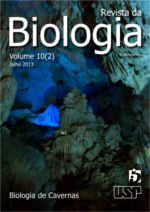Dinâmica populacional do bagre cego de Iporanga, Pimelodella kronei: 70 anos de estudo
DOI:
https://doi.org/10.7594/revbio.10.02.06Palavras-chave:
Peixes cavernícolas, Ecologia populacional, Monitoramento, Pimelodella kronei, Brasil.Resumo
O bagre cego de Iporanga, Pimelodella kronei, do Alto Ribeira - SP, foi o primeiro peixe troglóbio descoberto no Brasil e um dos mais estudados. Esses bagres foram excessivamente coletados na década de 1970 e, por isso, houve um declínio populacional detectado por Trajano 10 anos mais tarde. O presente estudo aborda a dinâmica populacional de P. kronei nas cavernas Areias de Cima e de Baixo, com foco nos deslocamentos no habitat, crescimento individual, fator de condição, e distribuições das freqüências de comprimento-padrão e fator de condição. Para tal, a população foi acompanhada entre outubro/2008 e maio/2010, através de marcação e recaptura, comparando-se aos resultados de Pavan (1945) e Trajano (1987). Este é o primeiro monitoramento de longo termo para peixes cavernícolas brasileiros.Downloads
Os dados de download ainda não estão disponíveis.
Downloads
Publicado
2018-04-23
Edição
Seção
Artigo
Licença
Salientamos que nossa revista não detém copyright, estes são exclusivos do autor do texto. Pretendemos com isso não criar entraves ao acesso do material publicado e atingir com mais intensidade nosso objetivo de divulgação da ciência.
Como Citar
Guil, A. L. F., & Trajano, E. (2018). Dinâmica populacional do bagre cego de Iporanga, Pimelodella kronei: 70 anos de estudo. Revista Da Biologia, 10(2), 34-39. https://doi.org/10.7594/revbio.10.02.06








 revistadabiologia@ib.usp.br
revistadabiologia@ib.usp.br 2008 - 2021 Revista da Biologia
2008 - 2021 Revista da Biologia